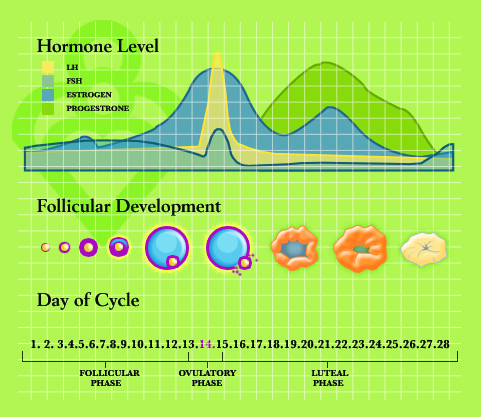Understanding ovulation can help you conceive

By understanding ovulation and the female hormone cycle you can more easily track your most fertile time to help with conception.
When a girl is born, she typically has between 1 and 2 million eggs in her ovaries. She will begin to lose these eggs early in life leaving her only 300,000 to 500,000 by the age of puberty.
As the eggs are formed, thin layers of cells (granulose cells) grow around them. The granulose cells and the oocyte (egg) are contained within a follicle. The follicle supports the egg it encloses for 50 years or more, providing it with nourishment but preventing it from maturing. The great majority of follicles and eggs never grow to maturity and ovulation. Follicles begin to develop, but if conditions for continued growth are not optimal, the eggs lose nourishment and die. The follicle cells then are absorbed back into the ovary. This continues throughout a woman’s life until all of the follicles are gone and she enters menopause.
Important hormonal processes lead up to ovulation
When a woman reaches puberty she begins her monthly menstrual cycle whereby a complex system of hormones command the ovaries to wake up follicles, release a mature egg and then shed endometrial lining if pregnancy does not occur.
During the hours leading up to ovulation when the mature egg is released from the dominant follicle, some important processes begin. First, the LH hormone (lutenizing hormone) rises in the blood. A few hours before ovulation, the primary oocyte undergoes a cell division process (meiosis) which results in an egg that contains 23 chromosomes. The follicle cells surrounding the oocyte secrete mucous, forming a circular barrier (the cumulus) around the oocyte. Beneath the cumulus is a glassy looking membrane called the zona pellucida. Sperm must be able to go through the cumulus and the zona pellucida of the egg in order to fertilize it.
Finally, the egg is released and is picked up by the fimbriated ends of the fallopian tube. Fertilization usually occurs in the fallopian tube 12-24 hours after ovulation.
Use these techniques to track your most fertile time
- Basal Body Temperature (BBT) – Keeping track of your BBT is a way to document whether you have ovulated. A specific hormonal change during your cycle triggers a rise in basal body temperature. By taking your temperature every day you can chart the rise of your temperature and the day you ovulate. The BBT chart will not predict when you are going to ovulate, but can serve as a record of your patterns. This will be helpful information for your physician.
- Ovulation Predictor Kits – Urine test kits to monitor lutenizing hormone (LH) are called ovulation predictor kits. They are designed to help you predict the time you will ovulate so that you can maximize your chances of getting pregnant. Most kits typically require you to perform a simple urine test. When you urinate on a special stick from this kit, it will document the surge of LH released by the pituitary just before ovulation, usually 24-38 hours before the egg is released. Most kits offer clear instructions for use and a toll-free number to call if you have questions.
If your menstrual cycles are consistently not regular, it may indicate you have a problem such as ovulation dysfunction or polycystic ovary syndrome. A fertility specialist can help you determine if problems with ovulation are preventing you from getting pregnant. Contact Fertility Answers to schedule a consultation with one of our specialists.


